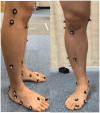Differences in lower extremity kinematics during single-leg lateral drop landing of healthy individuals, injured but asymptomatic patients, and patients with chronic ankle instability- a cross-sectional observational study
- PMID: 38512894
- PMCID: PMC10956788
- DOI: 10.1371/journal.pone.0297660
Differences in lower extremity kinematics during single-leg lateral drop landing of healthy individuals, injured but asymptomatic patients, and patients with chronic ankle instability- a cross-sectional observational study
Abstract
The lower-extremity kinematics associated with forward jump landing after an ankle injury is known to differ for patients with Chronic Ankle Instability (CAI), copers (injured but asymptomatic patients), and healthy individuals. However, the differences in the lower extremity kinematics of these groups associated with a Single-leg Lateral Drop Landing (SLDL) are unknown. The purpose of this study is to characterize the lower limb and foot kinematics during SLDL in CAI patients and to compare these characteristics with those of the copers and healthy individuals. This was a cross-sectional observational study. Nineteen participants, each, were selected from the CAI, Coper, and control groups. The lower-extremity kinematics during SLDL was measured using three-dimensional motion analysis over an interval progressing from 200 ms before landing to 200 ms after landing. Either one-way ANOVA or the Kruskal-Wallis test was used to compare the attributes of the respective groups, with each parameter measured every 10 ms. The maximum values and excursions of the parameters were established over time intervals progressing from 200 ms before landing to 200 ms after landing. Significant observations were subjected to post hoc analysis. Compared to the Coper group, the CAI group exhibited significantly smaller hip adduction angles at 160 ms, ankle dorsiflexion angles in the 110-150 ms interval, and maximum ankle dorsiflexion angles after landing. Compared to the control group, the CAI group exhibited significantly smaller excursions of MH inversion/eversion after landing. Our findings confirm the necessity of focusing on the kinematics of hip adduction/abduction and plantar/dorsiflexion during SLDL in evaluating patients with ankle injuries.
Copyright: © 2024 Sagawa et al. This is an open access article distributed under the terms of the Creative Commons Attribution License, which permits unrestricted use, distribution, and reproduction in any medium, provided the original author and source are credited.
Conflict of interest statement
The authors have declared that no competing interests exist.
Figures















Similar articles
-
Lower extremity joint kinematics of a simulated lateral ankle sprain after drop landings in participants with chronic ankle instability.Sports Biomech. 2022 Apr;21(4):428-446. doi: 10.1080/14763141.2021.1908414. Epub 2021 Apr 26. Sports Biomech. 2022. PMID: 33896373
-
Individuals with chronic ankle instability exhibit altered ankle kinematics and neuromuscular control compared to copers during inversion single-leg landing.Phys Ther Sport. 2021 May;49:77-82. doi: 10.1016/j.ptsp.2021.02.006. Epub 2021 Feb 12. Phys Ther Sport. 2021. PMID: 33621761
-
Lower Extremity Energy Dissipation and Generation During Jump Landing and Cutting in Patients With Chronic Ankle Instability.J Athl Train. 2023 Nov 1;58(11-12):912-919. doi: 10.4085/1062-6050-0452.22. J Athl Train. 2023. PMID: 36913640 Free PMC article.
-
Differences in the locomotion biomechanics and dynamic postural control between individuals with chronic ankle instability and copers: a systematic review.Sports Biomech. 2022 Apr;21(4):531-549. doi: 10.1080/14763141.2021.1954237. Epub 2021 Aug 19. Sports Biomech. 2022. PMID: 34412557
-
Individuals with chronic ankle instability exhibit dynamic postural stability deficits and altered unilateral landing biomechanics: A systematic review.Phys Ther Sport. 2019 May;37:210-219. doi: 10.1016/j.ptsp.2018.06.003. Epub 2018 Jun 13. Phys Ther Sport. 2019. PMID: 29914742
Cited by
-
Does chronic ankle instability patients lead to changes in biomechanical parameters associated with anterior cruciate ligament injury during landing? A systematic review and meta-analysis.Front Physiol. 2024 Aug 29;15:1428879. doi: 10.3389/fphys.2024.1428879. eCollection 2024. Front Physiol. 2024. PMID: 39268191 Free PMC article.
-
The Biomechanical Effects of Kinesiology Taping Methods on Side-Step Cutting Movements in Chronic Ankle Instability.Healthcare (Basel). 2024 Dec 19;12(24):2561. doi: 10.3390/healthcare12242561. Healthcare (Basel). 2024. PMID: 39765987 Free PMC article.
References
-
- Terada M, Pietrosimone B, Gribble P A. Individuals with chronic ankle instability exhibit altered landing knee kinematics: potential link with the mechanism of loading for the anterior cruciate ligament. Clinical Biomechanics. 2014; 29(10): 1125–1130. doi: 10.1016/j.clinbiomech.2014.09.014 - DOI - PubMed
Publication types
MeSH terms
LinkOut - more resources
Full Text Sources
Medical

